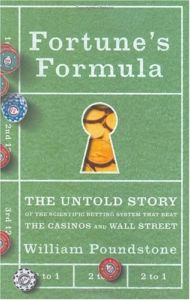Join getAbstract to access the summary!

Join getAbstract to access the summary!
William Poundstone
Fortune's Formula
The Untold Story of the Scientific Betting System That Beat the Casinos and Wall Street
Hill and Wang, 2005
What's inside?
What do information theory, hedge funds and blackjack have in common? Find out and learn how to beat the market.
Recommendation
This is a fascinating book about the sociology of ideas and, specifically, about information theory. Author William Poundstone explores how Claude Shannon, the major developer of information theory, affected finance, investing and gambling. These activities seem disconnected, but they all rely on managing uncertainty. Like any great idea, information theory attracted major personalities: gamblers, mobsters, academics, economists, traders and people who just wanted to make money. The story weaves through a collection of memorable people (from seventeenth-century mathematicians to Ivan Boesky) to present pertinent mathematical and scientific theories, and to explore how people used them. At times, the connections between events seem strained, but they all come together. This book is encyclopedic, exceptionally informative, and packed with great stories and characters. getAbstract.com enthusiastically recommends it to anyone seriously interested in investing, the sociology of ideas, or gambling. Indeed, read it twice: once for its theories and practical investment advice, and the other to relish its personalities.
Summary
About the Author
William Poundstone is the author of nine nonfiction books, two of which (Labyrinths of Reason and The Recursive Universe) were nominated for the Pulitzer Prize.



















Comment on this summary